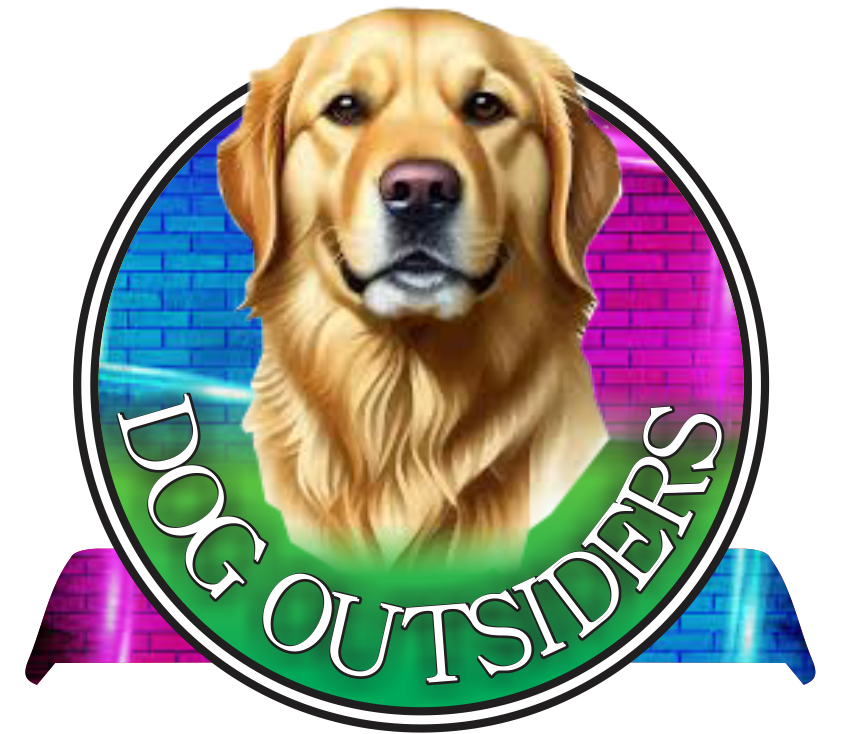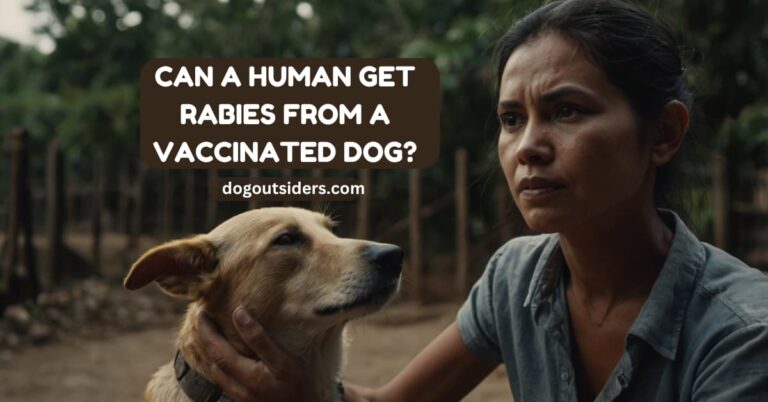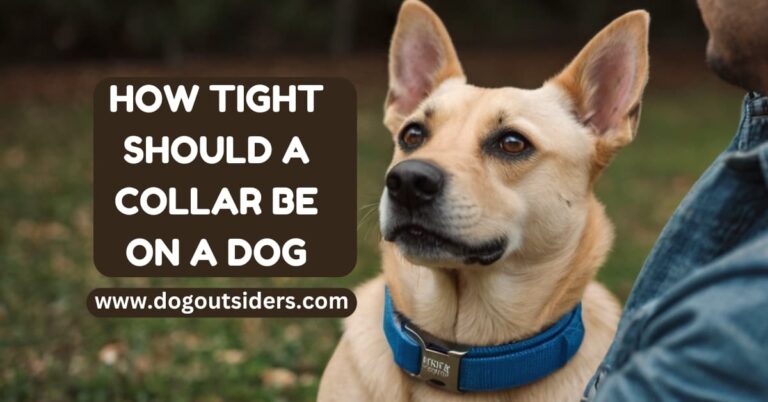You ever wonder why your dog pants at night? Dogs can pant for plenty of reasons. Some are downright harmless, like feeling too cool or a little antsy.Sometimes, that nighttime panting hints at bigger problems that need a vet’s eye. I’ve witnessed firsthand how a dog’s panting can stress a pet parent out.
Understand when to be concerned and when to leave them be. Let’s explore the reasons behind that nighttime panting and when you should take action. Recognizing these signs can help keep our furry friends happy and healthy.
Key Takeaways
- Dogs pant at night for many reasons, including being warm, stressed, or excited. Knowing these normal behaviors can help pet owners create a comfortable environment for their furry friends.
- If your dog’s panting seems excessive or is unusual, it may need medical attention. Look out for additional symptoms, such as coughing, lethargy, or appetite changes. These signs can point to several potential underlying health issues.
- Common health problems that may cause night panting include respiratory and heart conditions, obesity, or even pain from arthritis. It’s worth keeping an eye out for any more signs to keep your dog healthy.
- Heavy panting may also indicate anxiety or fear. Think about any recent changes in your dog’s routine or environment that may have caused stress. Then, work on coming up with a soothing environment for them.
- Keep your dog hydrated and give her a place to cool down. That will take care of her regular panting. Regular exercise and a balanced diet also help to prevent obesity-related panting.
- If you’re worried about your dog’s panting, consult with your veterinarian. They can give your pet a general health check and provide specific advice based on your pet’s needs.
Why Dogs Pant at Night
Panting at night is a pretty normal behavior for our furry companions, especially after an energetic play session. It’s important for pet parents to understand that this is a normal bodily process for dogs to cool off, as they don’t sweat like humans do. On a warm day, after a great run in the park, your pooch may start panting to regulate their body temperature.
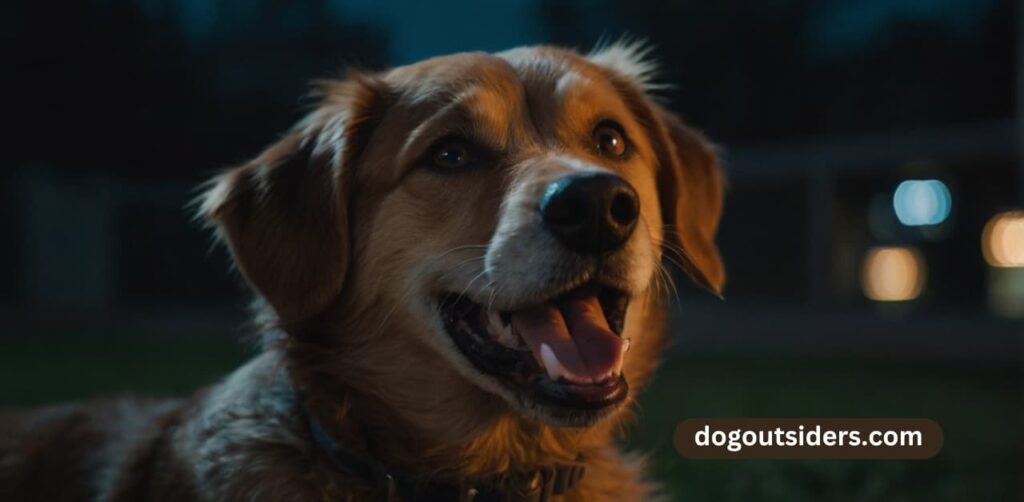
However, when this occurs during cooler nights, it can indicate potential health problems. Excessive panting can be a sign of underlying health conditions, such as respiratory issues or anxiety. If your dog exhibits restless behavior or shows signs of distress, it may be time to consult experienced vets for an accurate diagnosis.
Observing your canine companion’s breathing patterns is crucial, as heavy breathing at night could signal a significant health issue. If you notice abnormal breathing or any other concerning signs, don’t hesitate to reach out to your nearby emergency veterinary hospital for immediate attention. Keeping an eye on your dog’s behavior can help ensure their good health and restful nights.
1. Common Reasons for Panting
One important sign to pay attention to is pain, which can lead to excessive panting as stress hormones like cortisol shoot up in the system. Imagine having a toothache or a sore muscle; it’s no different for dogs. They could be trying to tell us something by panting more than normal, especially during warmer days when they may also be feeling the effects of humid weather.
If your dog is also restless or has a faster heart rate, this may be associated with pain or anxiety. Additionally, older dogs tend to have more issues due to weaker muscles, leading to more difficulty finding movement. This can result in sleepless nights for both the dog and pet parents, as they pace around trying to find comfort.
Stress and anxiety are also huge triggers for dogs. Just like us, dogs can become stressed out by loud noises such as thunderstorms or fireworks. During these events, you may notice them panting heavily, which is a sign of their distress and could indicate a need for veterinary care.
Older dogs tend to face more complicated issues when it comes to stress and anxiety. They are also more prone to developing health conditions like Cushing’s disease, which can lead to high stress levels and panting, especially during the evening hours when they might be trying to settle down.
In addition to Cushing’s disease, anemia is another common reason why dogs may pant at night. Understanding these potential causes and their triggers can help in managing your dog’s stress and ensuring their well-being, allowing for restful nights.
Diseases like heatstroke and respiratory issues are other suspects that can cause excessive panting. Heatstroke, which occurs when the temperature exceeds 106°F (41°C), leads to dehydration and heavy breathing, making it particularly dangerous for certain breeds.
Some breeds, especially brachycephalic dog breeds like Boston Terriers and pugs, are more likely to be affected due to their anatomy. Because of this, you really have to watch them closely, especially during hot days, and ensure they have access to cool water and a comfortable environment.
2. Environmental Factors
The environment your dog is in plays a huge role in their well-being. Hot, humid weather can lead to excessive panting, making it more difficult for your canine companion to cool down. This is particularly evident during warm days when you may notice your pooch exhibiting restless behavior. With that in mind, it’s essential to ensure good airflow and cooling methods are in place, especially in the blistering summer months. You will notice the difference that a fan or air conditioning makes in maintaining your dog’s normal breathing rate.
Another step you can take to help ease any environmental stressors is to create a comfortable resting area for your dog. A cool, quiet corner of the house can become their sanctuary, providing a space where they can retreat from the heat. This is crucial for dog parents who want to ensure restful nights for their furry friends.
One easy way to help them cool down is to ensure they always have fresh water. Keeping your dog hydrated is an effective trick that helps mitigate the effects of heat and prevents potential health problems associated with dehydration. It’s essential to monitor their water intake, especially during hot days, to keep them happy and healthy.
Additionally, be aware of the signs of overheating, such as heavy breathing or excessive panting, which may indicate that your dog requires veterinary attention. By being proactive and attentive to your dog’s needs, you can significantly improve their comfort and overall health during the hot months.
3. Emotional Triggers
Other emotional triggers like anxiety or stress can make your dog pant. You may notice this shift when the home routine changes.
It can also occur if your dog is in solitude for long periods. Creating a safe space for your dog during these times can be very beneficial.
This safe space could be a quiet corner with their favorite toys and bedding where they can feel secure and comfortable.
There are also calming techniques and products available, such as pheromones or calming supplements. These can be beneficial for dogs that experience emotional stress.
If you frequently see your dog panting due to anxiety, it may be time to consult with a dog behaviorist. They can provide tailored advice and strategies to help make your pooch more comfortable in stressful situations.
Here’s a quick checklist to help manage nighttime panting:
- Check for signs of pain or discomfort.
- Ensure the environment is cool and comfortable.
- Identify any potential stressors or changes in routine.
- Consider calming aids or consult a professional if needed.
When to Seek Veterinary Advice
While it can be hard to know when to call the vet about your dog’s panting, recognizing the signs of distress is crucial for your pet’s health. If your canine companion is having trouble breathing or their gums appear pale, these are warning signs that you need to seek veterinary care immediately. Excessive panting can indicate a serious health issue, especially in brachycephalic dog breeds, and should not be ignored.
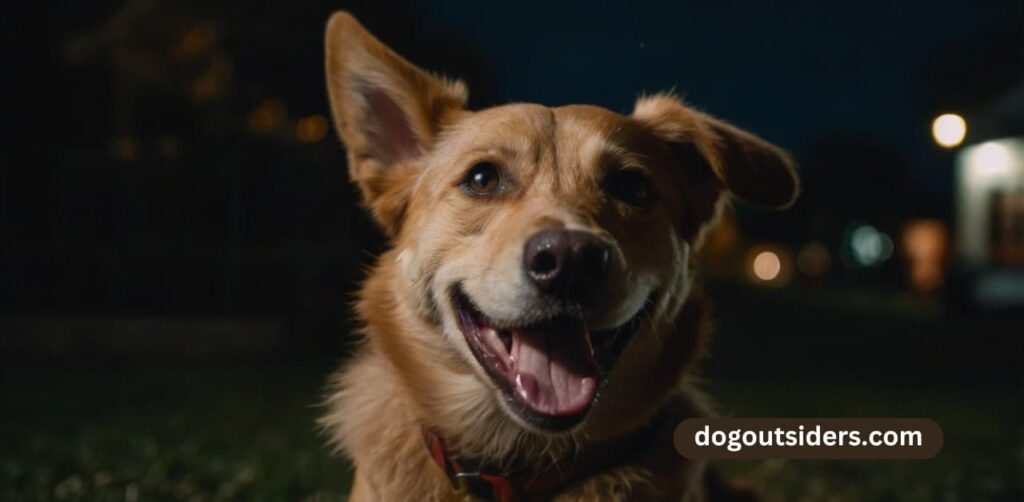
Imagine you’re relaxing on your couch, and your dog is exhibiting restless behavior, panting for no apparent reason. If that panting persists and the situation doesn’t improve, it’s time to take action. Don’t hesitate—call your nearby emergency veterinary hospital for assistance and ensure your furry friend receives the care they need!
1. Signs of Health Concerns
How do you know when your canine companion’s panting is more than just a response to hot weather? First, observe for any unnatural panting patterns that occur without an obvious cause. Signs such as heavy breathing, coughing, or reluctance to eat can indicate possible health problems. If your pooch appears to be in pain, that could be a significant warning sign as well.
Documenting any changes in their behavior, like pacing or restlessness, is crucial. This record may provide your experienced vets with valuable insight during your next visit. Keeping track of these signs can help them make an accurate diagnosis, especially if you notice symptoms like excessive panting or unusual breathing issues.
It’s essential to consider the conditions affecting your furry friend. For instance, humid weather can exacerbate breathing problems, particularly in brachycephalic dog breeds. If your dog is experiencing distress during warmer days, it might be time to seek veterinary care, especially if you observe rapid breathing or signs of overheating.
Finally, remember that many dog parents overlook the importance of monitoring their pet’s health during play sessions. An energetic play session can lead to increased cortisol levels, which may result in abnormal breathing patterns. Being proactive about your companion animal’s health can lead to restful nights for both you and your legged family member.
- Abnormal panting without a clear cause
- Coughing, lethargy, or appetite changes
- Signs of pain or discomfort
- Changes in behavior
2. Persistent Panting Indicators
Persistent panting is another thing to track, especially during warm days. If your dog pants a lot or for a long time, write it down, as this behavior might indicate that they’re not as playful as usual or that they appear to be struggling a bit more to breathe. Unusual breathing sounds can also be a concern, particularly in humid weather when breathing problems may arise.
It’s important to consider the environment when assessing your dog’s panting. Is it too hot, or perhaps too stressful for them? Even in ideal weather conditions, persistent panting could indicate an underlying health condition that requires veterinary care.
Keeping a close eye on these signs can help you determine if a visit to the veterinary clinic is necessary. Many dog parents may overlook the potential causes of excessive panting, but understanding these signs can lead to an accurate diagnosis and ensure your canine companion remains in good health.
3. Unusual Behavioral Changes
You can tell me with behavior if it’s going to change. Sometimes it helps to observe if your dog begins pacing or is suddenly restless. This type of panting may indicate stress or discomfort.
Pay attention if their routine or habits change at the same time as panting. It’s like putting a puzzle together.
Certainly, talk about these changes with your veterinarian. They can offer insights and assuage your concerns.
Let’s remember the essential facts. If you notice signs of heatstroke, such as excessive panting or drooling, head to the vet right away.
BetterVet says 80% of dogs with heatstroke exhibit symptoms quickly, such as within 15 minutes of heat exposure. If your dog is panting a lot at night, especially when it’s cool, that might be serious.
They could be in pain from something like arthritis. If there’s any excessive panting, consulting a vet is the way to go. They’ll look at your dog and collaborate with you to get them feeling right.
Health Issues Related to Panting
As a dog owner, one of the most worrisome sights is seeing your canine companion panting heavily at night. While panting is a normal bodily process, especially after an energetic play session or during humid weather, excessive panting may indicate serious health issues. Understanding the possible causes behind your dog’s restless behavior can help you determine whether a trip to the veterinary clinic is necessary.
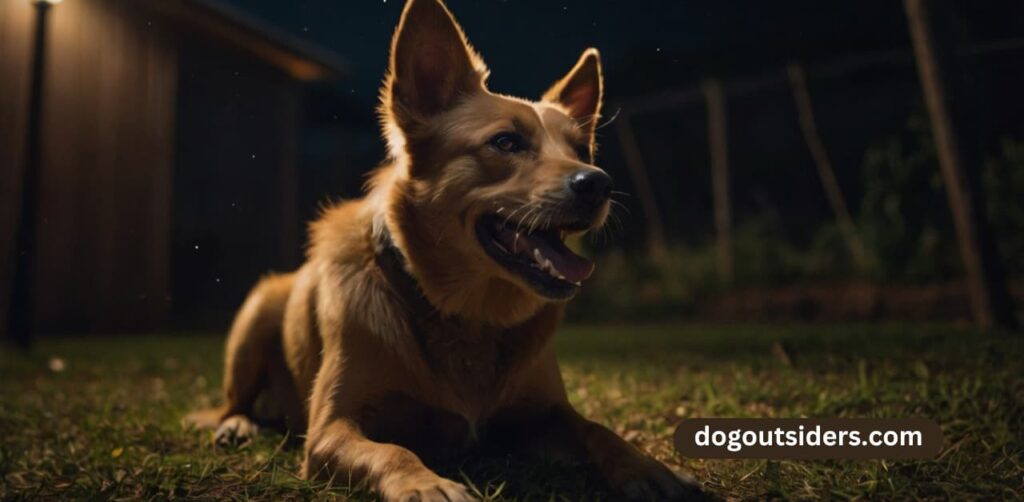
It’s crucial to monitor the situation closely and observe for other symptoms that may accompany the fast breathing. Common causes of abnormal breathing patterns can include underlying health conditions, such as asthma or lung tumors. If your pooch shows signs of distress, including heavy breathing or excessive thirst, it may be time to seek veterinary care during business hours or at a nearby emergency veterinary hospital.
Respiratory Problems in Dogs
Pay very close attention to your dog’s breathing, especially during humid weather. Watch for any signs of respiratory distress, such as wheezing or labored breathing, which could indicate a serious health issue. If your dog exhibits restless behavior or heavy breathing, it might be time for a visit to the veterinary clinic.
If your dog is panting more than normal, it might be due to underlying health conditions such as pneumonia. Your vet is your canine companion’s lifesaver, providing the necessary veterinary care to allow your pet to breathe easy again.
Be aware of your dog’s breathing passages, as obstruction or irritation could also be culprits of abnormal panting. Whether that’s a foreign object or allergy symptoms, being proactive in seeking treatment can make a significant difference.
Watch your dog’s breathing carefully, especially during the warmer days. If it exceeds 40 breaths per minute when at rest, get in touch with your vet immediately! A healthy dog’s respiratory rate typically ranges between 15 and 35 breaths per minute.
- Wheezing or whistling sounds when breathing
- Persistent coughing
- Difficulty catching breath
- Nasal discharge
Additionally, during hot days, dogs can experience increased cortisol production, leading to excessive panting. If you notice your dog pacing or showing signs of anxiety, it’s crucial to assess the situation and consider the possibility of overheating.
In conclusion, understanding your dog’s normal breathing rate and being vigilant about any changes can help prevent serious health problems. Always consult experienced vets for accurate diagnosis and appropriate treatment. Your furry friend relies on you to ensure their good health and well-being.
Heart Conditions and Panting
Heart conditions can be a significant factor when it comes to panting in dogs. If your canine companion has heart disease, their respiratory rate may increase, causing them to pant excessively to fill their lungs with enough oxygen. In those cases, you may also notice symptoms such as coughing or lethargy in addition to the panting, which could indicate an underlying health condition.
Regular check-ups are crucial for monitoring your dog’s heart health and ensuring they have restful nights. These routine visits allow experienced vets to assess your dog’s cardiovascular system and catch any potential issues early, which can lead to better health outcomes.
If any signs of heart failure or other cardiovascular issues arise, it is important to investigate promptly. Early detection can significantly improve the outcome and quality of life for your dog, especially if they are experiencing anxious behaviors or rapid breathing during humid weather.
Remember, heart conditions can lead to fluid accumulation in the lungs, which can make your dog have a hard time breathing. This is a serious concern that requires immediate veterinary attention, particularly if you notice symptoms during the evening hours.
Overall, being attentive to your dog’s breathing issues and scheduling regular wellness exams can help prevent significant health problems. Don’t hesitate to reach out to your local veterinary clinic for an appointment if you observe any alarming signs in your furry friend.
Pain and Anxiety Effects
It’s not only physical health issues that can impact your dog’s breathing, especially during humid weather. Pain and anxiety play a significant role as well. Dogs suffering from pain due to injuries or conditions like arthritis may experience excessive panting at night, leading to sleepless nights for both the pooch and pet parents. They may also exhibit behaviors such as pacing, signaling that something isn’t quite right.
Watch out if your dog is limping or appears reluctant to move; these behaviors can indicate pain and may require veterinary care. It’s crucial to observe their movements closely and identify any signs of discomfort. If you notice signs of heavy breathing or excessive thirst, it may be time for a visit to the veterinary clinic for an accurate diagnosis.
Plan how to alleviate their discomfort, considering suitable medications or therapies that may help. Consulting with experienced vets can provide insight into the best options for your dog’s specific needs, especially if they are one of the brachycephalic dog breeds prone to respiratory issues.
For anxiety, behavioral training and environmental modification can be very effective. Creating a calm, safe space for your canine companion can alleviate some of their concerns, particularly in warmer weather. This safe environment can make it easier for them to breathe and feel secure, ultimately improving their overall well-being.
In addition, ensure that your dog’s exercise routine is adjusted to the ideal weather conditions. Shorter walks during cooler nights can help prevent overheating and excessive panting, allowing for more restful nights.
Remember, if you notice any unusual behaviors or significant changes in your dog’s breathing, seek veterinary attention promptly. Your furry friend deserves to be healthy and happy, and addressing these issues can lead to a better quality of life for both of you.
Understanding Excessive Panting
Any change in your furry friend’s behavior, especially at night, can be concerning for pet parents. One such behavior is excessive panting, which can sometimes indicate more than just a quirky canine habit. This rapid breathing can signal various underlying health conditions, and it’s essential for dog lovers to understand the possible reasons behind it, particularly during humid weather or warmer nights.
Panting can indicate a dog’s struggle with normal breathing rates or even anxiety, particularly in brachycephalic dog breeds. It’s crucial to monitor your canine companion for signs of restlessness or heavy breathing, as these can lead to sleepless nights for both you and your pooch. If you notice excessive panting or other alarming behaviors, seeking veterinary care during business hours or finding a nearby emergency veterinary hospital may be necessary for an accurate diagnosis and peace of mind.
Identifying Excessive Panting
What exactly is excessive panting in dogs? Well, it occurs when your canine companion’s breathing rate exceeds the normal range, often seen during warm days or after an energetic play session. However, if your dog is breathing more than 40 breaths a minute while lying still, that’s a significant red flag indicating a potential health issue. In such cases, seeking veterinary care is crucial.
For this reason, I recommend closely monitoring how much and how long your dog pants, especially during humid weather or cooler nights. Are there certain triggers, such as loud noises or changes in routine, that cause these panting spells? Identifying these patterns can be vital in understanding your pet’s behavior.
To gain better insight, consider keeping a checklist of these episodes. Break it down by the time of day, activity level, and any other factors you notice. This systematic approach helps you spot patterns and makes it easier to share insights with your veterinarian during your next visit.
Additionally, jotting down when and how often your dog pants in a table or chart form provides a great visual tool for understanding their behavior. This can help you determine if there are underlying health conditions that need attention, especially if you notice signs of restlessness or heavy breathing.
Ultimately, being proactive about your dog’s health can lead to better outcomes. If you notice excessive panting or other unusual behaviors, don’t hesitate to contact your nearby emergency veterinary hospital for an accurate diagnosis and peace of mind. Your furry friend depends on you to ensure their good health and well-being.
Causes of Excessive Panting
Excessive panting in dogs can often be attributed to a combination of factors, ranging from simple environmental influences to more serious health concerns. For instance, factors in the environment, such as high temperatures and humid weather, can lead to your dog panting more than usual, especially during warm days.
To illustrate, imagine you are in an air-conditioned room, and it’s not hot, yet your canine companion is panting as if he has just run a marathon. In this scenario, it could be a sign of anxiety or possibly an underlying health condition that requires attention.
Stress from changes in routine or psychological factors could also be responsible for this restless behavior. It’s essential for pet parents to consider these factors when assessing their dog’s panting, especially during the evening hours.
Health conditions such as Cushing’s disease are common in older dogs, affecting approximately 1 in 5 dogs over ten years of age. This disease can lead to various symptoms, including nighttime panting and increased cortisol production.
Other serious health issues, such as heart failure or anemia, can also cause similar reactions in dogs, leading to fast breathing and excessive thirst. Monitoring these conditions closely is vital for your furry friend’s well-being.
Additionally, maintaining a list of possible allergens or irritants can help identify triggers for nighttime panting. Common allergens may include pollen, dust mites, or certain foods that could lead to allergy symptoms in your dog.
Heatstroke is another serious concern when temperatures soar above 106°F. In such conditions, dogs may experience heavy breathing and dehydration. It’s crucial to keep your dog cool and hydrated during extreme heat to prevent these dangerous situations and ensure restful nights for both you and your pet.
Differentiating Normal from Abnormal
Now, let’s take a look at what’s normal and what’s not. After a fun romp in the park, it’s perfectly normal for your pooch to pant. This is a natural response to physical exertion and helps them cool down.
However, if they’re panting heavily at night, with no apparent reason, then it’s time to dig deeper. Unexplained panting can be a sign of discomfort or an underlying health issue that needs attention.
Here’s where a checklist comes in handy. Compare their panting during rest with their panting during activity. This comparison can provide valuable insights into whether the panting is typical or something that requires further investigation.
If you have any concerns, don’t hesitate to ask your vet for clarity. They can help determine if the panting is normal for your dog or if it indicates a potential problem.
Keep a close eye on your dog’s health and behavior. Panting may signal severe problems like a heart issue that traps fluid in your lungs. It could also be a sign of anemia, which you would likely feel fatigued and have a fast heartbeat.
If your dog’s midnight panting seems out of the ordinary, a vet visit is a wise move.
Here’s a simple checklist to help you assess:
- Is it more than 40 breaths per minute at rest?
- Time of Day: Does it happen mostly at night?
- Triggers: Are there specific stressors or changes in routine?
- Are there signs of diseases like Cushing’s or heart problems?
Conclusion
Panting at night in dogs is a mystery to a lot of pet parents. I’ve turned over the common causes and the health issues behind this. It’s not always a cause for alarm, but sometimes it hints at something more serious. If your pup pants a lot, check for signs of stress or discomfort. After a long day of play, your furry buddy may be tired. Or maybe they just want a cooler place to snooze! Be wary of heavy panting with no apparent cause.
Trust me, I understand how hard it is to know when to call the vet. Listen to your instincts. If your dog’s panting doesn’t seem right or you notice other concerning symptoms, get in contact with a professional. Better safe than sorry, right?
Have any other questions or need assistance? I’m here. Please reach out any time to keep your pet healthy and happy. Let’s keep our four-legged friends wagging their tails with joy!
Frequently Asked Questions
Some dogs might start panting at night due to anxiety or heat, particularly in humid weather, or even pain, which can lead to sleepless nights for both pets and pet parents. Observing your canine companion’s behavior can help identify possible causes. If the panting is excessive, it’s wise to consult experienced vets for an accurate diagnosis.
Occasional panting can be normal, as it can indicate your dog is too warm or too excited, especially in humid weather. However, heavy or constant panting could indicate a serious health issue, requiring veterinary attention.
Health issues such as heart disease, respiratory disease, or Cushing’s disease can lead to excessive panting in pets. An accurate diagnosis from experienced vets is essential for identifying these conditions.
Excessive panting in dogs is more common and severe than normal breathing rates, often accompanied by signs like restlessness, drooling, or lethargy, indicating potential health issues.
You should seek veterinary care if panting persists, worsens, or is accompanied by other symptoms such as excessive thirst or collapse. Early intervention is key.
Yes, panting can be due to anxiety, with underlying causes such as thunder, other loud noises, or a change in environment. Many dog parents notice this restless behavior in their canine companions during stressful situations, which may lead to excessive panting and an increased respiratory effort.
Provide your canine companions with a calm environment and calming aids, like anxiety wraps or pheromone diffusers, to help alleviate their restless behavior.
